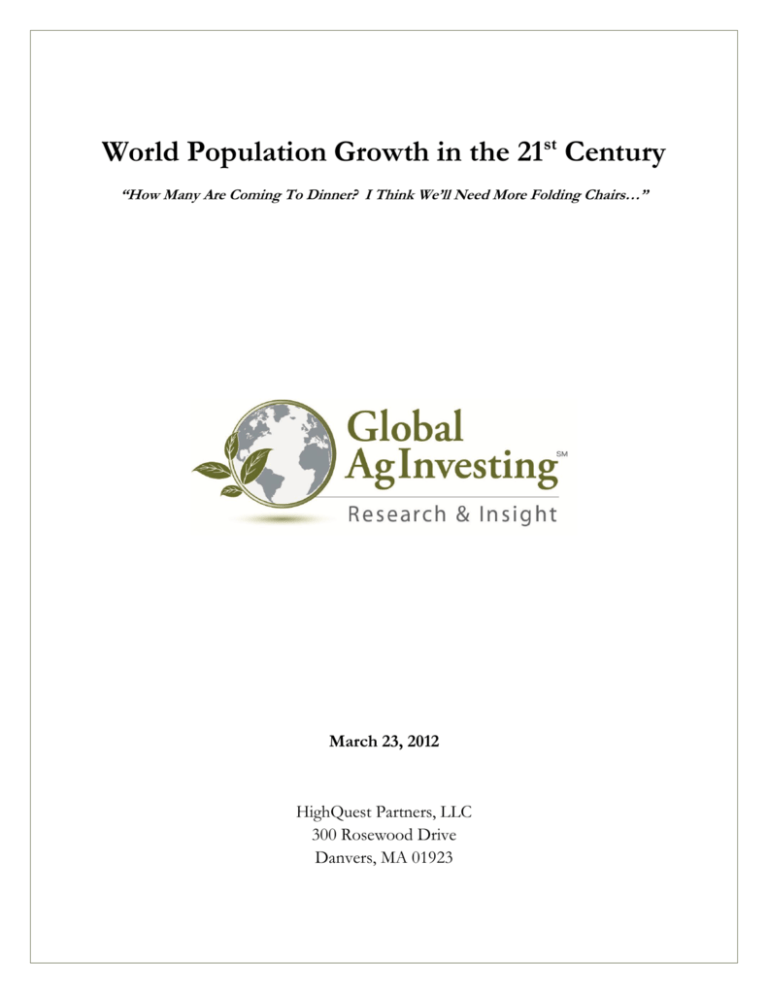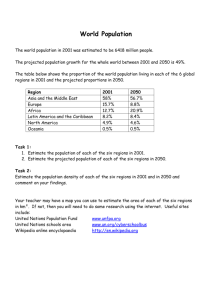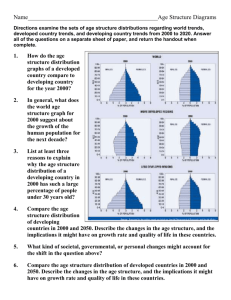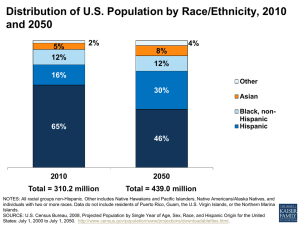
World Population Growth in the 21st Century
“How Many Are Coming To Dinner? I Think We’ll Need More Folding Chairs…”
March 23, 2012
HighQuest Partners, LLC
300 Rosewood Drive
Danvers, MA 01923
World Population Growth in
the 21st Century
“How Many Are Coming To Dinner? I Think We’ll
Need More Folding Chairs…”
Until the 11th millennium BC, humans relied on hunting and gathering for their sustenance; a system that kept
the world’s population in check at an estimated one million people for many thousands of years. Then
something revolutionary happened... humans invented the practice of agriculture and everything changed.
By AD 300-400, it is estimated that more than 50-60 million people lived in the combined Eastern and
Western Roman Empires alone.
As a result of the Agricultural and Industrial Revolutions, compulsory vaccinations, and continuing
improvements in sanitation and medicine, world population has expanded for the past seven centuries, even
in the face of large population losses due to world wars and disease. Between 1700 and 1900 Europe’s
population quadrupled from approximately 100 million to over 400 million. Between 1750 and today the
population of the Indian subcontinent increased 9.8 times from 125 million people to 1.2 billion. In this
century alone the population of Mexico grew 8.3 times, from 13.6 million to 112 million. Kenya’s population
increased 12.8 times, from 2.9 million in 1920 to 37 million today.
The world’s population has steadily
increased since the peak of the Bubonic
Plague during 1348-13501, with its
highest annual rate of increase
Population Milestone
Year of Milestone
Years Since Previous Milestone
1 million
10,000 BC
190,000
occurring in 1963- 2.2%. In 2000, the
1 billion
1830 AD
12,000
United Nations Population Division,
2 billion
1930 AD
100
3 billion
1960 AD
30
Department of Social and Economic
4 billion
1975 AD
15
Affairs estimated that the world’s
5 billion
1989 AD
14
6 billion
1999 AD
10
population was growing at an annual
7 billion
2011 AD
12
rate of 1.14% or 75 million people per
8 billion
2025 AD
14
9 billion
2045 AD
20
year. By 2009, the world’s population
was increasing by over 80 million
Sources:
Luc-Normand Tellier (2009) "Urban World History: an Economic and Geographical Perspective"
annually; 220,980 people every day or
over 9,200 people every hour – so by the
United Nations, Department of Economic and Social Affairs, Population Division (2011).
World Population Prospects: The 2010 Revision, CD-ROM Edition.
end of your lunch break, there were over 9,200
Population projections are from the medium case scenario
more people on earth. The United Nations
Population Division predicts that by 2050 the world’s population will be between 8.1 billion and 10.6 billion
people, with a median estimate of 9.3 billion – and every one of them will be asking “What’s for dinner?”
Global Population Milestones
Historical and Projected
Bubonic Plague is a zoonotic (transferred from animal to human) disease which is spread by small rodents and their fleas. The infection is caused by
the bacteria Yersinia Pestis, which is transferred from rodents to humans via biting fleas. If untreated, two thirds of Plague victims will die within four
days of infection. DNA testing has conclusively linked Bubonic Plague as the cause of the Black Death which swept through Europe beginning in
1346, and killing an estimated 30 to 60 percent of the continent’s population. By the time this pandemic burned itself out, it killed an estimated 100
million worldwide, reducing global population by 22% from 450 million to 350 million by the time it burned itself out. It took over 150 years before
the population of Europe returned to pre-Black Death levels. The Black Death is significant to the story of global population growth because it is the
last time that human population experienced a decline.
1
Copyright 2012 All Rights Reserved. No reproduction, distribution, or transmission of any portion of this work is permitted without the written
permission of HighQuest Partners, LLC, 300 Rosewood Drive, Danvers, MA 01923
Page
2
The Mathematics of Population Growth: The world’s human
population does not grow linearly, but rather geometrically, (i.e., 1, 2, 4, 8,
16…, etc.) which explains the five-fold increase in population from 1.2
billion to 6.1 billion during the 20th Century. Rapid population growth is
predicted to continue for the first half of the 21st century, with rates of
growth declining during the latter half of the century. World population
is projected to stabilize at just over 10.1 billion by 2100.
"Population, when unchecked,
increases in a geometrical ratio."
--Thomas Robert Malthus
Despite the projected stabilizing of population by the end of this century, rapid growth is expected in the next
40 years, and will likely place a huge burden on global resources and the agriculture sector in particular. To
give you an idea of just how fast population is now growing, consider the following average growth rates for
the period 2010-2050, calculated from UN Population Division predictions:
Copyright 2012 All Rights Reserved. No reproduction, distribution, or transmission of any portion of this work is permitted without the written
permission of HighQuest Partners, LLC, 300 Rosewood Drive, Danvers, MA 01923
Page
3
(To put into perspective just how big a number 10.1 billion is, if you decided to count every person on earth
at the rate of two per second, it would take you over 160 years to complete the task.)
Where in the World?: Population
is growing most rapidly in the least
developed and developing nations
of the world, while population
levels in the most developed
nations are expected to remain flat
or even decrease. Over the next 40
years, 97.1% of the projected
increase will occur most markedly
in Africa and Asia.
By 2050 Asia is projected to be
home to 55.3% of the population
of the world and Africa to 23.5%
of the world.
If predictions
materialize, just fewer than 80%
(78.8%) of the entire world
population will be living in Africa
and Asia alone. Africa’s population
will increase by 155.9% by 2050
from 2010 levels.
Though Africa and Asia will be
home to the most people, they are
not alone in anticipating huge
population increases. By 2050
Central America’s population is
projected to increase by 68.7%, the
Middle East’s by 58.9% and
Oceania’s by 50.9% while the
population of the European Union
will decrease by 3.2%.
These population trends indicate a
coming shift in demographics that
will not only place a great demand
and stress on the resources and
infrastructure of the nations in
question, but the world as a whole.
In this age of globalization, a
challenge for one nation means a
challenge for all.
Copyright 2012 All Rights Reserved. No reproduction, distribution, or transmission of any portion of this work is permitted without the written
permission of HighQuest Partners, LLC, 300 Rosewood Drive, Danvers, MA 01923
Page
4
Current and Projected Population by Major Global Region 2010-2050
2010 Population
(Thousands)
2050 Population
(Thousands)
Percent Change
Africa
Asia
Europe
Caribbean
Central America
South America
Northern America
Australia & New Zealand
Rest of World
856,327
4,164,252
738,199
41,646
155,881
392,555
344,529
26,637
175,863
2,191,549
5,142,221
719,257
47,314
215,569
488,073
446,862
37,063
18,220
155.9%
23.5%
-2.6%
13.6%
38.3%
24.3%
29.7%
39.1%
-89.6%
World
6,895,889
9,306,128
35.0%
Sources and Notes:
United Nations, Department of Economic and Social Affairs, Population Division (2011).
World Population Prospects: The 2010 Revision, CD-ROM Edition.
Population projections are from the medium case scenario
The Age of Urbanization: Not only will there be a huge demographic shift between regions of the world,
but within countries as well. The 21st century is the age of urbanization; urban areas of the world are
expected to gain 2.9 billion people by
2050. In 2009, 3.4 billion people lived in
urban areas, and this is predicted to reach
6.3 billion by 2050. In fact, between now
and 2050, urban areas of the world will be
absorbing all of the world’s population
growth while also absorbing emigration
from rural areas as well. As a result, there
will likely be 0.5 billion less rural
inhabitants in 2050 than today. Again,
this shift will mainly occur in developing
areas.
Asia’s urban population is
predicted to increase by 1.7 billion,
Africa’s by 0.8 billion and Latin America’s
and the Caribbean’s by 0.2 billion each.
Overall, 68.7% of the entire world
population will be city dwellers by 2050 as
opposed to 28.8% in the 1950’s and
49.5% in 2009. By 2050, China will have
an urban population of 1 billion people
while India will have 0.9 billion living in
urban areas.
Today the world has 21 of what are
referred to as megacities, those cities with 10 million inhabitants or more. Up until 1975 the world had only
three megacities, New York, Tokyo and Mexico City. As soon as 2025, the number of megacities is projected
to be 29, with Asia having 16, Latin America, 6, Africa, 3 and Europe and North America 2 each.
Copyright 2012 All Rights Reserved. No reproduction, distribution, or transmission of any portion of this work is permitted without the written
permission of HighQuest Partners, LLC, 300 Rosewood Drive, Danvers, MA 01923
Page
5
“So?” you ask. “If the problem is the number of people on earth, does it matter if they live in cities?” Well
the answer is “Yes, it certainly does matter.” Every person living in those cities will need to be fed and not
occasionally, but constantly. We all rely on those in our rural areas to grow our food, raise the cattle, produce
the milk and harvest the grains that keep our societies fed and working. By 2050 there will likely be 0.5
billion less people in a position to do this for a population that is 2.3 billion greater than it is today.
Longevity, Gender and the Consequences of Population Control Mandates: There are more factors to
consider when discussing population, including those of longevity and gender. Due to better healthcare,
access to education and economic growth, life expectancy has risen across all socioeconomic groups across all
areas of the world. The most rapidly growing age group worldwide is those over 80 years old. At the same
time, in developing nations, the number of young people is expanding as well. In more developed nations,
children under 14 make up only 17.0% of the population, and there are 4.1 adults working for every child. In
Sub-Saharan Africa the number of young people is 42.0% of the population and there are only 1.3 working
adults per child. In Uganda the ratio of working people to children is 1:1, while women in that country have
on average more than six children each.
At the opposite end of the spectrum from Uganda is
China. In 1970 the average woman in China also had six
or more children. Then in 1978, China implemented its
one-child policy in an effort to improve its standard of
living and its economy as a whole. Urban couples and
those of Han heritage may only have one child while
couples in rural areas (in general) may have a second
child five years after the birth of their first child, or if the
first child is a girl.
“If we don't halt population growth with
justice and compassion, it will be done for
us by nature, brutally and without pity- and
will leave a ravaged world.”
-- Dr. Henry W. Kendall, Nobel Laureate
In terms of simple population control, the policy has seemed to work. Since 1995 China’s birthrate has
stabilized at 1.7%. By essentially eliminating approximately 400 million extra people, the one-child policy has
also increased China’s standard of living and strengthened its economy, by concentrating the country’s
economic growth in the hands of fewer people. Currently, China is the 2nd largest economy in the world after
the US and in 2010 its GDP was
China's 2010 Population by Age Group
9.3% of the world total2, and its
per capita GDP (current USD) has
Age Groups
Total
Male
Female Ratio Male to Female
grown at a compounded annual
0-4
81,595
44,689
36,906
1.21
5-9
84,050
46,225
37,825
1.22
rate of 9.1% over the past ten
10-14
95,313
51,776
43,537
1.19
15-19
105,348
56,449
48,899
1.15
years.
Economic growth is considered
desirable, but at what cost? The
government
of
China
acknowledges
some
societal
drawbacks to its one-child policy.
China’s is one of the most aging
societies on earth. By 2050 30%
2
20-24
25-29
Over 30
Totals
119,964
100,759
754,311
62,788
51,849
382,566
57,176
48,910
371,745
1.10
1.06
1.03
1,341,340
696,342
644,998
1.08
Of all persons under the age of 30 in China, males exceed females by 40.5 million
China's "one child" policy was enacted in 1978, 34 years ago
Source:
United Nations, Department of Economic and Social Affairs, Population Division (2011).
World Population Prospects: The 2010 Revision, CD-ROM Edition.
Source: International Monetary Fund 2010 GDP Estimates. Estimates are in current US dollars.
Copyright 2012 All Rights Reserved. No reproduction, distribution, or transmission of any portion of this work is permitted without the written
permission of HighQuest Partners, LLC, 300 Rosewood Drive, Danvers, MA 01923
Page
6
of its population will be over 60. Due to a preference for male heirs in Chinese society, China is experiencing
a birthrate of 121 males for every 100 females. Males under 30 years old outnumber females by 40 million,
and the stress of possibly not finding a mate is potentially a casual factor in cases of mental health problems
and disruptive social behavior among these men. It is true that China’s one-child policy has generated wealth
and globalization, but with that extra wealth and freedom of movement it is becoming more difficult to
impose.
Conclusions: Feeding the world’s rapidly growing population in the 21st century is a daunting challenge for
the agricultural sector. Without even factoring changing global diets, we estimate that total global agricultural
output will need to increase by 70% to 100% in the next 38 years. To achieve this required output, massive
investment in the agriculture is needed from both the public and private sectors.
Given this insight to our collective future, we have today the knowledge, resources and technologies to meet
the demands that will face us. The development of agriculture is what sparked our species’ success and
enabled our populations to reach today’s levels. Significant investment in agriculture and alternative forms of
energy must begin now instead of later to ensure that there are enough folding chairs for everyone at the
table.
Copyright 2012 All Rights Reserved. No reproduction, distribution, or transmission of any portion of this work is permitted without the written
permission of HighQuest Partners, LLC, 300 Rosewood Drive, Danvers, MA 01923
Page
7
Sources:
1. United Nations, Department of Economic and Social Affairs, Population Division (2011). World
Population Prospects: The 2010 Revision, CD-ROM Edition
2. United Nations Department of Economic and Social Affairs/Population Division, World
Urbanization Prospects: The 2009 Revision
3. World Population Prospects – The 2010 Revision, Population Database, Population Seven Billion:
UN Sets Out Challenges
4. World Population Highlights: Key Findings from Population Reference Bureau’s 2010 World
Population Data Sheet
5. Luc-Normand Tellier (2009) "Urban World History: An Economic and Geographical Perspective"
6. Science Daily: World Population to Surpass 7 Billion in 2011; Explosive Population Growth Means
Challenges for Developing Nations
7. Index Mundi: China Economy Profile 2012
8. International Monetary Fund 2010 GDP Estimates
Disclaimers and Notes of Forward Looking Statements:
The information provided herein is not an offer to sell, or a solicitation of an offer to buy any security,
investment product or service. This material was prepared solely for informational purposes and it is
distributed with the understanding that HighQuest Partners LLC is not rendering legal, accounting or other
professional services. There is no guarantee that forecasts discussed will be realized. A variety of factors,
many of which are beyond the control of HighQuest Partners, LLC, may affect performance and results and
could cause actual performance and results of investments to be materially different from any future
performance or results that may be expressed or implied by any forward looking statements.
Copyright 2012 All Rights Reserved. No reproduction, distribution, or transmission of any portion of this work is permitted without the written
permission of HighQuest Partners, LLC, 300 Rosewood Drive, Danvers, MA 01923
Page
8
Appendix:
www.pbr.org/Publications?PopulationBullitins/2010/worldpopulationhighlights2010.aspx?p=1
Copyright 2012 All Rights Reserved. No reproduction, distribution, or transmission of any portion of this work is permitted without the written
permission of HighQuest Partners, LLC, 300 Rosewood Drive, Danvers, MA 01923
Page
9
Appendix:
Copyright 2012 All Rights Reserved. No reproduction, distribution, or transmission of any portion of this work is permitted without the written
permission of HighQuest Partners, LLC, 300 Rosewood Drive, Danvers, MA 01923
Page
10





